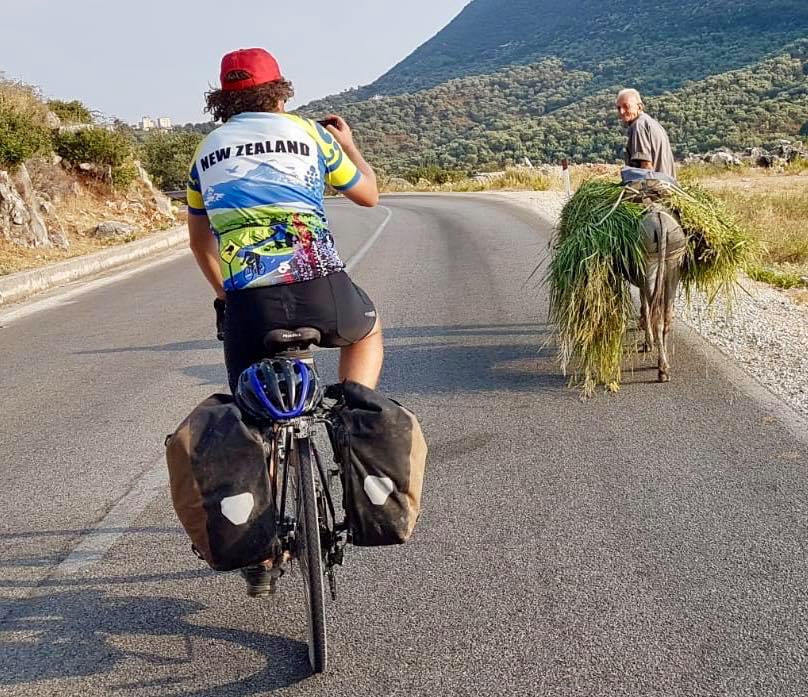TIRANA, February 7
The title says something, but the story of Malbec Pilgrim about his time in Albania last summer tells everything to people who love to explore the world on the bike. The Mission of Malbec is to entertain and inspire about traveling the world by bike, as it is the most optimal tool for slow travel to draw out the experience of the places he explores.
Malbec says that traveling by bicycle is no longer just for the adventurous. On the contrary, it is gaining a lot of popularity. He’s been mostly focused on Latin America, but over the last years he found out that the Balkans are great for cycle-touring.
Friendly people, stunning sceneries, and quiet roads are just a few among the elements that guarantee an awesome time in Albania.
Here’s What Malbec Pilgrim Wrote about his experience:
Perhaps one of the least-visited Eastern European countries by western travelers. We cycled about 320km from the capital of Tirana in the north-central of the country, down to Saranda in the south where there are regular ferries to the Greek island of Corfu for our flight back.
The first day was the toughest, in boiling 35+ temps on some pretty awful gravel through steep hills. It was an exhausting 100km to Berat, but the city is totally beautiful and worth the effort to get there. A UNESCO World Heritage Site, it’s one of the oldest cities in Albania. It was one of the highlights of the whole trip.
From Berat, we headed out to the coast to Albania’s 3rd largest city of Vlore which was about the halfway point for cycling.
From Vlora down to Saranda we were treated to mile upon mile of Mediterranean coastline. I guess sparkling clear water and chillaxed summer holiday vibes aren’t necessarily the first things Westerners think of when someone says “Albania”; like a lot of more remote former Eastern Bloc territories it suffers from an image problem in the West and Albania is perhaps 2nd-only to Borat’s Kazakhstan for pejoratives.
But anyone with an atlas can tell you that the Albanian coastline is what joins Greece with the Balkan coast of Croatia and Montenegro, and it, therefore, stands to geological reasoning that the coastline would be much the same. And indeed it is, complete with all manner of swim spots from buzzing popular beaches to quiet coves really only accessible by boat, and everything in between.
There is a main, sealed road which runs from Vlore down to Sarande which wasn’t too heavy with traffic. Okay, so it’s definitely not isolated country riding by any means, but in the first week of September (ie. the first week of shoulder-season after the high-season of July-August), it was manageable enough. That said there were plenty of opportunities to get away from the traffic, especially when the road occasionally veered a little away from the seaside and instead there were coastal trails to be chased. The trails were more built (if that’s the word….) with pedestrians than cyclists in mind, and my own anecdotal experience would say they were 80% cycle-able at a slow pace, and the remaining 20% I was walking the bike. Just don’t plan on much more than say 6k over an hour and you should be okay.

Despite being mainly coastal, the southern half of Albania did smack us with the single biggest climb of our trip – a 1000m+ behemoth taking us up through the Llogora National Park and passed the base of Mt Cika. I’d only taken a cursory look at the climb before heading out to Albania; it was over 24km so MapMyRide suggested an average gradient of just over 4% which sounded manageable enough. It wasn’t until I was 17km in when I realized we’d only climbed 370 meters, with the final 630 meters all to come in the final 7km – or 9%. The sting was really in the tail of that climb, and in 35+C temperatures, I was sweaty-wet to the point of dripping by the time I hauled myself into a cafe/restaurant with a panoramic view at the top.
After a night in the chilled beach town of Himara, we had 2 nights in Saranda in order to spend a full day in the area just south of it, which is home not only to the nicest beaches of Albania around Ksamil but also to the ruins of the ancient city of Butrint. Butrint was a key city in the area during Roman times, but archeological history suggests the town had been there in various forms since 10th century BC. Pretty old.

Albanians are quite proud of their ancient history. At more than one place during our cycle down the coast, we read about how Julius Caesar had travelled there personally with his armies as the final part of his campaign to defeat Pompey and transform the Roman Republic into an Empire.
The nearest international airport to southern Albania is actually on the Greek Island of Corfu – regular ferries link Saranda with Corfu town (journey time varies from 35 to 90 minutes depending on which ferry). After arriving in Corfu we had to get used to the initial price shock, as Albania = v. cheap, but Corfu Old Town = priced for the Western tourist market, including mega cruise ships, etc. Prices for everything basically seemed to double, as we said farewell to 5 euro Long Island Ice Teas and just accepted that they now cost a tenner (at least). Corfu old town kinda reminded me of Dubrovnik a little – nice to look at but left wondering where the heart really was among the wall-to-wall overpriced gelato shops and postcard stands.
Some photos courtesy of @Jey Webb
Source/Credit: Malbec Pilgrim
Read also: The Most Scenic Drives in Albania
Best Autumn Road – Trips in Albania
The Best Road Trips in Albania

Leave a Reply
You must be logged in to post a comment.